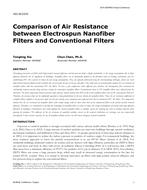Description
Developing innovative air filters with high particle removal efficiency and low pressure drop is highly worthwhile, as the energy consumption due to high-efficiency filtration can be significant in buildings. Nanofiber filters can be potentially applied in the filtration units of heating, ventilation, and air-conditioning (HVAC) systems to reduce the fan energy consumption. They are typically fabricated using the electrospinning technique, which can reach high particle removal efficiency with relatively low air resistance because of the gas slip effect. This study aims to systematically compare the air resistance of nanofiber filters with the conventional HVAC filters. To have a fair comparison under different face velocities, the investigation first examined the relationship between pressure drop and face velocity for electrospun nanofiber filters. Experimental data of 122 nanofiber filters were collected from the literature. The linear regressions between pressure drop and face velocity showed that 89% of the tested nanofiber filters had an R² value greater than 0.9. Therefore, the pressure drop can be confidently regarded as being proportional to the face velocity for nanofiber filters. Then, the air resistance coefficients of nanofiber filters, defined as the pressure drop over the face velocity, were calculated and compared with that of commercial HVAC filters. The comparison showed that the air resistances of nanofiber filters with careful design could be lower than that of the commercial filters with similar particle removal efficiency. Therefore, it is worthwhile to develop the technology of nanofiber filters in order to reduce the energy consumption associated with high-efficiency filtration in buildings. Furthermore, this study applied the selected nanofiber filters as window screens for reducing the entry of outdoor particles when opening the windows. The influence of the air resistance of nanofiber window screens on the natural ventilation air exchange rate was numerically investigated. Under certain scenarios, the use of nanofiber window screens can still ensure adequate natural ventilation.
Citation: 2018 Annual Conference, Houston, TX, Conference Papers
Product Details
- Published:
- 2018
- Number of Pages:
- 10
- Units of Measure:
- Dual
- File Size:
- 1 file , 2.5 MB
- Product Code(s):
- D-HO-18-C010




